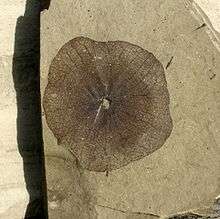Florissantia
| Florissantia Temporal range: Eocene to Oligocene | |
|---|---|
 | |
| Florissantia sp. flower | |
| Scientific classification | |
| Kingdom: | Plantae |
| (unranked): | Angiosperms |
| (unranked): | Eudicots |
| (unranked): | Rosids |
| Order: | Malvales |
| Family: | Malvaceae |
| Subfamily: | Sterculioideae |
| Genus: | Florissantia Manchester |
| Species | |
|
Florissantia ashwillii | |
| Synonyms | |
|
Porana speirii Lesquereux | |
Florissantia is a fossil flowering plant of western North America known from compression fossils from the Eocene to Oligocene (56 to 23 million years ago) found in several localities, including fossil beds in British Columbia, Washington State, Oregon, and Colorado.[1] The plant is known from fossils of its flowers, fruits, and pollen.
References
This article is issued from Wikipedia - version of the Tuesday, March 19, 2013. The text is available under the Creative Commons Attribution/Share Alike but additional terms may apply for the media files.